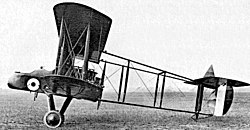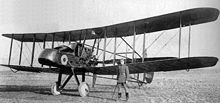Royal Aircraft Factory FE2
| Royal Aircraft Factory FE2 | |
|---|---|

|
|
| Type: | Bomber / reconnaissance aircraft |
| Design country: | |
| Manufacturer: | |
| First flight: |
February 1914 |
| Commissioning: |
September 1915 |
| Production time: |
1914-1918 |
| Number of pieces: |
1939 |
The Royal Aircraft Factory FE2 was a two-seat British bomber ; but the machine could also be used as a fighter plane . The aircraft, equipped with a pusher propeller , was used in the First World War from autumn 1915 . Together with the single-seat Airco DH2 , it was supposed to fight against the previously superior German Fokker monoplane .
History and construction
The FE2 ( F arm- E xperimental 2 ) was developed by the Royal Aircraft Factory developed and evolved from the previous machine FE1 . In 1913 the design was completely revised and a prototype developed for the series machine. In February 1914 it was totally destroyed in a crash.
Shortly before the beginning of the First World War, the Royal Flying Corps ordered the first series machines, although machines with pusher propellers were considered obsolete. However, the British did not yet have a synchronized machine gun, as was used in the Fokker monoplane to fire forward through the propeller. The FE2 was a two-seat aircraft; the gunner sat in front of the pilot. The observer initially operated a 7.7 mm Lewis machine gun , and later two. The observer's view was excellent. The FE2. could also carry a small amount of bombs.
The first series of twelve FE2a was quickly retired and replaced by the FE2b . It initially had a 120 HP (89 kW) water-cooled Beardmore in - line engine , which was later replaced by a Beardmore engine with 160 HP (119 kW) power. The FE2c was a night bomber, the seat positions of the pilot and observer were reversed.
The FE2b was from September 1915 at No. 6 Squadron of the RFC put into service. Two thirds of the machines flew as fighters and one third as bombers. A total of 1939 FE2b and FE2c were built.
They flew as day bombers until 1917, then as night bombers until August 1918. There were 16 RFC squadrons in France and a maximum of six squadrons in the English home defense.
The last model was the FE2d , of which 386 machines were built. It was powered by a 250 hp (186 kW) Rolls-Royce Eagle engine. In this version, a machine gun was mounted above the upper wing. Here the observer had to stand in flight to fire backwards. However, this was a delicate position in aerial combat. Some machines had a permanently mounted forward-firing Lewis machine gun that the pilot could operate.
From 1917 it became more and more difficult to fight the modern German hunters. However, the pilots praised the machine for its stability. Manfred von Richthofen was seriously injured in the head in June 1917 when he was fighting with several FE2. was.
The FE2 was also used to combat submarines; the machine was also equipped with air bags to give it a certain buoyancy in emergency landings.
Military use
- Australian Flying Corps only one copy
Technical data (FE2b)
| Parameter | Data FE2b |
|---|---|
| crew | Pilot and observer |
| length | 9.83 m |
| span | 14.55 m |
| Wing area | 45.9 m² |
| height | 3.85 m |
| Empty mass | 935 kg |
| Max. Takeoff mass | 1378 kg |
| drive | 1 water-cooled in-line engine Beardmore , 160 HP (119 kW) |
| Top speed | 147 km / h |
| Service ceiling | 3353 m |
| Range | k. A. |
| Armament | Max. 3 x 7.7 mm Lewis MGs, max. 235 kg bombs |
literature
- CF Andrews, EB Morgan: Vickers Aircraft since 1908. Putnam, London 1988. ISBN 0-85177-815-1 .
- JM Bruce: The FE2 Series: Historic Military Aircraft, No 3. Flight, December 12, 1952, pp. 724-728.
- Walter Raleigh: The War In The Air: Being the Story of the Part played in the Great War by The Royal Air Force: Vol I. Clarendon Press, Oxford 1922.
- John WR Taylor: FE2b. Combat Aircraft of the World from 1909 to the Present. GP Putnam's Sons. New York 1969. ISBN 0-425-03633-2 .
- Jim Winchester: Royal Aircraft Factory FE2. Biplanes, Triplanes and Seaplanes (Aviation Factfile). Grange Books plc. London 2004. ISBN 1-84013-641-3 .




